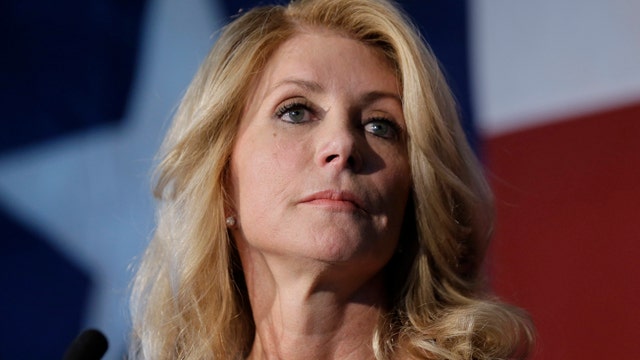Is Wendy Davis' political star fading in Texas?
Liz Chadderdon and Katrina Pierson on the Democrat's chances against Greg Abbott
To the extent that Democrats dream in Technicolor, the grand dream would be turning Texas from red to blue in future presidential elections.
Why? Add Texas’ 38 electoral votes to the mega-state troika of California, Illinois and New York and the sum is 142 – more than midway to the magical 270. Toss in another dozen reliably blue states and the Democrats’ haul climbs to 256. Republicans would have to all but run the table in the remaining 34 states – including battleground Colorado, Florida, Ohio and Virginia – to ever have a viable shot at the Oval Office.
As Jerry Seinfeld would say: “good luck with all that.”
How close are Democrats to flipping the Lone Star State? Barack Obama received only 41% of the statewide vote in 2012, down 2.5% from 2008 (by contrast, Michael Dukakis received 43.3% of the November 1988 presidential election running against Texas transplant George H. W. Bush).
And Hillary Clinton’s chances in 2016? Currently, not so robust, if Wendy Davis’ current gubernatorial run is a benchmark.
About Davis: she rose to political notoriety in June of last year for waging a 12-hour filibuster, on the floor of the Texas Senate, to delay a state bill adding to and updating abortion regulations. That landed the state senator in the pages of Vogue and in East Coast salons where pro-choice activists implored her to run to become Texas’ 48th governor.
That moment in June would also prove to be her political high-water mark.
The first sign of trouble for Davis: though she received 78% of the vote in the Democrats’ March primary, she fared poorly in heavily Hispanic, predominately Catholic communities in South Texas – Democrats she may lose in November thanks to the pro-choice brand.
Texas surveys show the pro-life position holding a 10% advantage statewide. It may explain why, though Davis continues to run as a women’s rights champion, she’s now talking about ending the statute of limitations on rape and sexual battery cases in Texas, rather than making her candidacy a straight referendum on abortion.
A second problem: at the heart of Davis’ appeal was a feel-good story of a woman overcoming life’s hardships. That was until a January Dallas Morning News report that punched holes in her biography – the made-for-Lifetime tale of a divorced teenaged mother who lived in a trailer and earned her way to Harvard Law wasn’t quite as it was advertised.
That prompted Davis’ campaign to issue this statement from the candidate: “I am proud of where I came from and I am proud of what I’ve been able to achieve through hard work and perseverance. And I guarantee you that anyone who tries to say otherwise hasn’t walked a day in my shoes.”
What she didn’t note: her Republican opponent, Texas Attorney General Greg Abbott, is a paraplegic.
If elected, Davis wouldn’t be making Texas political history; two women – Miriam “Ma” Ferguson and Ann Richards – have run the Lone Star State, albeit a half-century apart. However, Davis is trying to reverse the political order. Texas hasn’t held an open-seat gubernatorial contest since 1990. The winner of that election: Richards, the last Democrat to serve as governor. In the five gubernatorial elections since, the closest a Democrat’s come to the governor’s office is 45.9% (Richard’s take, in 1994, while losing to George W. Bush).
Running on personality and biography, one would assume a Davis campaign swathed in sunshine and optimism (think Obama and “hope” in 2008). Instead, it’s been darkness and slight.
Davis’ highest-profile ads this summer? That would be a pair of buys suggesting that Abbott was unsympathetic toward rape victims and opposed to cancer research.
Curiously, what’s missing from the candidates’ ads would be . . . the candidate herself. Why would Davis, under attack from one web site for being too attractive, decide not show her telegenic self? Perhaps, because she’s a polarizing figure. An April survey by Public Policy Polling found the state senator with a 32% favorability rating among women and 33% among men; Abbott led 49-41% among women and 53%-32% among men.
Not every election is a fait accompli – certainly when Texas early voting doesn’t begin until Oct. 20 and the two gubernatorial contenders will debate in McAllen three Fridays from now (a second debate, in Dallas at the month’s end, hangs in limbo as the two sides have clashed over format).
In the meantime, Davis has to figure a way around these hindrances: a polling deficit perhaps as high as 12.8% (that’s the Real Clear Politics average); a 3-1 money disadvantage (Abbott is so well-financed that he’s running ads in movie theaters); local news that overshadows the governors race (current Texas Gov. Rick Perry’s indictment; the ongoing refugee crisis along the Mexican border).
Collectively, it suggests that Wendy Davis, a year after filibustering in a pair of pink Mizuno Wave Rider 16 runners, is running an uphill race – in a Texas that isn’t quite as blue as Democrats would like to dream it is.

